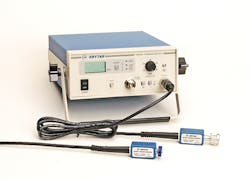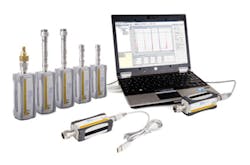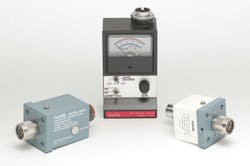This file type includes high resolution graphics and schematics when applicable.
Microwave power meters are among a collection of instruments, such as oscilloscopes, spectrum analyzers, signal generators, and vector network analyzers (VNAs), that should be on every high-frequency designer’s workbench. Over the last decade, the variety of available RF/microwave power meters has grown, to where these instruments are now available in many shapes and sizes, from rack-mount units to portable instruments and even meters that can be powered and controlled by a laptop computer using a USB connection. Along with the meters, the “other half” of the instrument, the power sensor, is also available in many varieties, providing engineers with a tremendous assortment of meters and sensors for almost any application. Understanding the different performance parameters for power meters and their sensors can help when comparing different available instruments.
RF/microwave power meters can be judged and compared by a number of key specifications that serve as a starting point when trying to find an instrument suited for a particular application. These parameters include frequency range, power measurement dynamic range and resolution, and whether power measurements can be made on pulsed or continuous-wave (CW) signals and whether a meter/sensor combination can measure peak envelope power (PEP).
A power meter’s performance limits, such as frequency range and power measurement range, are basically those of its connected power sensor. Several different technologies are used in power sensors to measure power, including those based on diode detection and those measuring power as a function of thermal effects, such as thermistor- and thermocouple-based power sensors. Each has different performance levels in terms of power measurement range and accuracy, but each is effective depending on the needs of an application.
For more details on the basics of making RF/microwave power measurements, including the differences between average power measurements and pulsed power measurements, Keysight Technologies offers an excellent, 80-page application note (64-1B), “Fundamentals of RF and Microwave Power Measurements,” for free on its website. The application note includes information on the different power sensor technologies along with a brief explanation of power sensor calibration methods and the use of the microcalorimeter power-measurement reference standard established by the National Institute of Standards & Technology (NIST) at their facility in Boulder, Colo.
Power in Smaller Packages
Measuring power, which is essentially energy per unit time, has traditionally been performed by a combination of a power meter and a sensor, and the power meter has typically been among the most compact of instruments on an RF/microwave test bench. Perhaps the most evident trend in modern power meters has been the shift away from this two-part instrument combination toward smaller, more integrated power-measurement solutions, usually powered by means of a USB port and a PC.
As an example of the traditional power meter/sensor combination, the model 9000B power meter from Krytar uses diode-based sensors to measure average CW power from -39 to +20 dBm over a frequency range of 100 kHz to 40 GHz (Fig. 1). This compact instrument is fully portable and can be used in the field as well as on a benchtop for swept measurements. It features NIST-traceable accuracy of ±0.05 dB when measuring 0 dBm (1 mW) at 50 MHz and room temperature (+25°C). Power measurement linearity is ±0.025 dB at room temperature. The compact power meter is 3.625 × 8.3125 × 11.50 in. and runs for more than 12 hours on rechargeable internal batteries.
Some applications, such as radar systems, may require power measurements on pulsed signals, and the model 4500B peak power analyzer from Boonton and the Wireless Telecom Group has been well established as a reliable measurement tool for pulsed power measurements. With a frequency range of 1 MHz to 40 GHz and video bandwidth as wide as 65 MHz, the power meter/sensor measures power levels from -50 to +20 dBm for pulse widths as narrow as 6 ns and at rise times of 7 ns or less.
The programmable meter can be set to trigger on a specific event or with a specific time delay when attempting to measure signals of interest. Voltage from its sensitive diode-based peak power sensors are processed by a 14-b analog-to-digital converter (ADC) to create digital measurement data that can be displayed on a color LCD screen or processed further for such functions as statistical analysis.
The PC Connection
This combination of power meter and sensor has long been the way to make power measurements at RF/microwave frequencies, but the increasing use of the PC, measurement software, and the USB is leading to the development of power sensors that can connect directly to PCs via the USB, with the computational power once provided by the separate power meter now handled by the PC. For example, several series of diode- and thermocouple-based USB power sensors from Keysight Technologies provide full-sized power measurement capabilities with the simplicity of USB connections to a PC (Fig. 2). The U2040 X-Series of USB power sensors are geared for wide-dynamic-range measurements, with a power measurement range of -70 to +26 dBm for a frequency range of 10 MHz to 33 GHz (depending upon sensor). The U2020 X-Series USB sensors provide peak and average power measurements across a power measurement range of -35 to +20 dBm for a frequency range of 50 MHz to 40 GHz (depending upon sensor). The U8480 Series USB thermocouple power sensors measure to 67 GHz (depending upon sensor) with better than 0.8% linearity for a power measurement range of -35 to +20 dBm.
The PWR series of USB power sensors from Mini-Circuits demonstrate just how small power measurement solutions have become at RF/microwave frequencies. The broadband model PWR-8GHS USB power sensor performs CW power measurements from -30 to +20 dBm at frequencies from 1 to 8000 MHz in a sensor package size of only 4.89 × 1.74 × 0.95 in. Designed for use with any PC with Windows or Linux operating system, the power sensors are supplied with measurement software. They feature automatic calibration and temperature compensation and achieve 30-ms measurement speed. The power sensors also include a Type-N-to-SMA coaxial adapter and a quick-locking USB cable for reliable connectivity.
As a form of bridge between the traditional power meter/sensor combination and these latest USB power sensors, Narda Microwave-East offers its compact 8400 Series of portable power meters and monitors (Fig. 3) provide power measurement ranges as wide as 1 μW to 1 mW at frequencies from 10 MHz to 12.4 GHz (and usable to 26.5 GHz). These completely portable measuring tools include analog meters on some models and field-replacement detection elements for long-term use in the field. They are compact and built with the ruggedness needed to survive in-field use.
Of course, with the simplicity of one connection to a PC with the proper installed software, the ease of setting up power measurements with a USB power sensor/meter explains the rapidly growing popularity of this method of power measurement. A large number of companies currently offer USB power sensors/meters for CW and peak power measurement, including Anritsu Co., Bird Technologies, Coherent Inc., Giga-tronics, Ladybug-Tech, Rohde & Schwarz, Satori Technology, Telemakus, and Tektronix.




